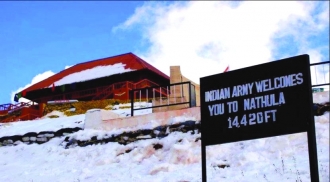
China’s repeated calls for the withdrawal of Indian troops from the vantage point of India-Bhutan-China tri-junction expose its restlessness. Surprisingly, Beijing reminded New Delhi to respect the Panchsheel Agreement. Nothing could be more whimsical than hearing the words of Panchsheel from the country which gave a damn about it in the past.
The face-off between the two countries started on the issue of road construction on a 269-sqkm plateau in Bhutan along the tri-junction. China claims the construction of border road is its legitimate right as it is being built on Chinese territory. According to the Chinese Foreign Ministry, India violated the Chinese boundary from the Sikkim side. This is a blatant lie. Indian troops have always been there at Bhutan border for several reasons: obviously one of the reasons is to keep an eye on Chinese incursion attempts in the eastern sectors. In fact, Bhutan has made it clear to China that Beijing is violating the 1998 Agreement — which stipulates that peace and status quo at the China-Bhutan border must be maintained — by trying to build the road on the tri-junction.
The strategic location of the region has aggravated the India- China tension. Doka La is at the tri-junction of Sikkim, Bhutan and Tibet and is strategically important for India as the crucial Siliguri corridor, known as “Chicken’s Neck” that is merely 50 km from Siliguri. This neck is the lifeline between the rest of India and North-Eastern States of the country.
If China gains access to the Doklam plateau, it would have the ability to essentially “cut off” India’s land access to 40 million citizens in its N-E region. An strategic expert said, “Chinese occupation of Doklam would jeopardise Indian defence completely. This piece of dominating ground not only has a commanding view of the Chumbi Valley but also overlooks the Siliguri Corridor further to the east.”
It is not surprising why China has accused India of breaching border. Reasons are plenty. First, Prime Minister Narendra Modi’s visit to America and resultant bonhomie triggered unexpected depression in China. The same was earlier seen after India’s nuclear tests and then US President Clinton’s visit to India. Beijing fears this friendship might change world’s stand on Tibet, which has remained an unresolved issue between China and the US. The complete mapping and designing of China has emerged from the Tibet issue. It was America which dropped Tibetan (Khampas) rebels in 50s and 60s in the Chinese mainland. However, the rebels could not maintain their tempo for long. The vast geographical distance between America and Tibet killed the spirit of the movement. China is now wary of India’s proximity to Tibet and Tibetans. Therefore, India-US joint venture could trigger a major strategic loss to China. Having anticipated this notion, China is very sceptical and apprehensive of India-America friendship.
Second, Modi has changed the trajectory of Indian foreign policy. India under Nehru and subsequent leadership lost its hold on the Himalayan belt. One after another country succumbed to Chinese pressure. However, Bhutan and Nepal are the only two buffer nations which are considered lopsided towards India. And this is why they are the next goals for China. Modi is aware of the Beijing’s ambitious grand strategy of Greater China. That is why he started his diplomatic itinerary from Bhutan and Nepal after becoming Prime Minister. It sent a lucid message to China. India of 2017 is not confused nor ideologically blind with preconceived notions. Unlike the previous Government, the Defence and Foreign Ministries are speaking with one voice. It seems the Chinese President has grasped the foreign policy of Modi and is wary of India’s unpredictable moves.
Third, China has been trying to lure Bhutan into accepting a package deal to sort out the boundary dispute. Beijing has resolved its boundary issues with all the neighbouring countries, including Russia, but not with India and Bhutan. China in 1996 and 2012 tried to woo Bhutan into acquiescing a swapping deal. There are three territorial areas of dispute between China and Bhutan. The Jakarlung and Pasamlung valleys are located in the Bhutan-Chinese north-central border. It has an area of almost 491 km. Another area of Chinese interest is situated on eastern part, in close proximity of Tibet. It is almost half of the north-central part. It is well known to the world that China has been building chains of highways and railways connecting Beijing to Lasha. It wants to move inside Bhutan, but China does not have diplomatic relations with Bhutan.
China claims Bhutanese, Sikkimese and Ladhakis form a united family in Tibet: they were subject to Tibet and to the great motherland of China. However, the fact is Tibetan nomads entered the pastures of the Doklam plateau and tried to occupy the territory in 1966. But China retreated from the region under tremendous US intervention. China made another bid in 1988 when the PLA crossed into Bhutan and took control of the Chumi Valley, below the Doklam plateau. Bhutan’s border issues with China are directly related with India-China border. Bhutan’s western border is close to Nathu La, the frontier port between China and India; the eastern border is connected to the disputed area of China and India; and the narrow passage which connects south-west and North-East areas is not far from Bangladesh.
Therefore, the border issue is inter-connected and it has spilling effects on the third country. Almost 470-kilometre-long border between Tibet and Bhutan could be properly understood in the context of the India-China border issue. The history of Bhutan proves that it has been attached to India like an umbilical cord. Moreover, Bhutan’s economy and defence rest on India’s help.
China’s economic trade with Bhutan is very marginal because high Himalayan mountains block any effort to think of transportation facility. Thus, large-scale trade activities cannot be supported and Bhutan can hardly become a strategic path for China. The Zhagmu Port on border of Nepal remains the main station for China to connect to the South Asian region through Tibet. And therefore, there is considerable recent evidence of China’s effort to inch closer to South Asia. Seen in this context, China signed a series of bilateral treaties with Nepal. China is trying to extract the same favour from Bhutan. China tried to establish full-fledged diplomatic relations with Bhutan in 2012, but India caught a whiff of it and convinced Bhutan not to fall in the dragon’s trap.
It has to be understood that Tibet is the linchpin of all this debate. India’s woes spill over from the acceptance of Tibet as an integral part of China under the One China policy. However, the same approval has boomeranged on India: Chinese claims on eastern and western sectors spring from the same thesis. According to China’s documented history, Tibetan Lamas, who were powerful in 12th to 16th centuries, ruled certain parts of mainland China and adjoining areas of Himalayan territories. Since Tibet is part of China, the documented history claims parts of North-Eastern States of India, Bhutan and Ladakh are integral regions of China.
Under the present Chinese hegemonic bids, the next pragmatic approach for India is to reject the often repeated theory of Tibet being an integral part of China. If China can violate the accepted terms and conditions signed with India, why India should respect the Chinese stand that is not binding by an agreement. Although, it is not an easy task, well begun is half done. And Prime Minister Modi is taking steps in that direction: “Make in India” and boosting ties with the US are paragon examples. India-US friendship has potential to spoil Chinese imperial designs.
By Satish Kumar
(The writer is Head of the Department of Political Science, Central University of Haryana)
For regular updates download Samachara Bharati app http://www.swalp.in/SBApp














